
Snickerdoodleforkids.com
Lesson Plan
“Snickerdoodle: What is a hero?”
![]() Download a printable PDF of the lesson
Download a printable PDF of the lesson
Language arts, American tall tales; storytelling;creative writing;
art; character education
(Note: This lesson plan, updated and adaptable for preK-grade 3,
actually includes multiple lesson ideas and sample creative activities
based on “Snickerdoodle.” It is not necessary to have
the Snickerdoodle storybooks in order to teach these lessons, but
storytelling skills are desirable, and the books may enhance the
lesson ideas. We hope teachers will find these ideas a useful and
fun starting point for creating meaningful and fun learning experiences
with their students.)
Objectives:
-
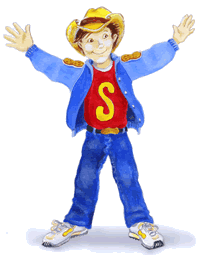 To introduce positive role models that counteract negative influence
of media and toy images of violent “superheroes.”
To introduce positive role models that counteract negative influence
of media and toy images of violent “superheroes.” - To
stimulate children’s thinking about qualities and
behaviors expressed by both real-life and fantasy heroes.
- To encourage creative writing and artwork about heroes in action,
or to create an original hero or Snickerdoodle story.
- To familiarize children with the folklore of American tall
tale heroes. Click here for resources on teaching American folklore.
- To reinforce Snickerdoodle’s message for kids: “You can be a hero, even if you’re just a ‘little guy.’ You can “think big”, be a peacemaker, and solve tough problems with humor, imagination, and courage. Never be afraid to be yourself—the world needs you and the special talents you can give. You’re never too little to make a difference.”
Materials needed:
- Snickerdoodle’s Message (for older kids)
and/or Snickerdoodle’s "RAP" Message
(for ages 3 and up). You can download and print out these poems,
along with color images of Snickerdoodle, and other characters,
from this website and make reprints for handouts to students.
Print out the poster of Snickerdoodle that says "Discover
small wonders on the road less traveled."
(Note: You can also hear/play aloud for the children the rap, songs, and one story on this website.
- Photos, images from newspapers, magazines, websites, etc. of “real-life” heroes
and fantasy “superheroes” of all kinds. (Children
can look for these and bring them to class.)
- Art room materials such as scissors, paste, crayons, markers,
paper (brown butcher paper or lunch sacks are great for using
to draw and cut out “peanutmobile” shape).
Children may write/draw stories in sketchbooks or online with computer software. - See List of creative writing websites for kids
Method:
NOTE: For very young children, teacher may lead brief discussion of “heroes,” follow-up with short introduction to Snickerdoodle, and then proceed to have kids engage in one of several activities:
- The “Snickerdoodle Rap” (music, movement)
- Designing, drawing, their own customized “peanutmobile” fantasy vehicle (art education)
- Playing the “On the road to adventure with Snickerdoodle” game,
using the full-color poster “Discover small wonders along the
road less traveled.” (alphabet skill, memory/sequence, language
arts, storytelling)
For older children, teacher may begin with discussion of heroes and move on to discussion of American tall tale heroes, involving students in creating/writing their own stories.
Lesson: What is a hero?
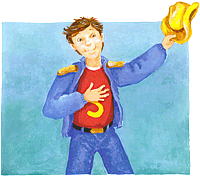 Teacher leads children in discussion,
showing photos and images of heroes and favorite superheroes,
and writing key word lists and children’s responses
on blackboard or large easel chart.
Teacher leads children in discussion,
showing photos and images of heroes and favorite superheroes,
and writing key word lists and children’s responses
on blackboard or large easel chart.
“Who is your favorite hero?” (Writes “hero” and children’s responses)
“What, exactly, IS a hero, anyway? What does he do? What sort of person is he or she?” (Teacher makes list on board or chart of children’s ideas. List might include guided answers such as: )
- Helps people.
- Rescues people/saves lives
- Brave
- Strong
- Courageous
- Bold
- Daring
- Unselfish
- Smart
- Kind
- Imaginative
- Humble (doesn’t brag or boast)
- Not afraid to step up and stop bad things from happening when no
one else will
- Not afraid to fight for a cause, a “big” idea, that
he or she believes in.
- Peacemaker—respects others, makes friends, and contributes good ideas that work to make the world better for everyone.
“What are some things a hero is NOT?” (Examples: A bully, a bragger, a liar, a showoff, a mean guy, etc.)
“Where do we find heroes?” (Discuss real-life everyday heroes and fantasy “superheroes” of books, TV, movies, cartoons, videos, etc.)
“Is being a famous person, a celebrity, or a superstar the
same thing as being a hero? Why or why not, do you think?
(Review discussion of qualities, behaviors if needed)
“Can a girl be a hero? Can you name some girls and women who are real-life
heroes or fantasy superheroes?” (examples?)
“Can animals and pets act like heroes?” (examples?)
“Does a hero have to be big or can he or she be small? Can you think of some big, giant-size heroes?” (Sports stars may come to mind, or you can introduce American tall tale hero Paul Bunyan)
“Can you think of some small-size heroes?” (David vs. Goliath is classic example, also fantasy characters like Mighty Mouse or “Veggie Tales” , or children’s literature characters Tom Thumb, Stuart Little, etc. )
The Teacher as “Storyteller” for Young Children
*OPTIONAL:Teacher can use the storybook to introduce Snickerdoodle! A Tall Tale About a Powerful Pee-Wee!
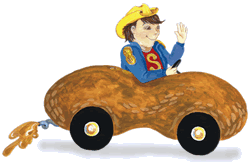 “Today I’m going to tell you about a tiny fantasy
superhero who thought big and did big things.
“Today I’m going to tell you about a tiny fantasy
superhero who thought big and did big things.
He has a funny name: SNICKERDOODLE!” (Write it on blackboard or easel.
Show images of Snickerdoodle on overhead projector)
And guess what ! He rides in a peanut! See, I told you he was SMALL!
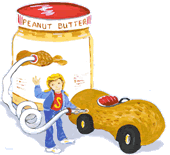 It’s a MAGIC peanut—because when Snickerdoodle
pushes a special button, that peanut can become a car, a boat,
a plane, or even a rocket ship! And Snickerdoodle could even
shrink and fold up that peanut and carry it in his pocket!
And what do you think the fuel of that peanutmobile is? Hint:
It’s
NOT gasoline!(children’s responses)You guessed
it! PEANUT BUTTER!
It’s a MAGIC peanut—because when Snickerdoodle
pushes a special button, that peanut can become a car, a boat,
a plane, or even a rocket ship! And Snickerdoodle could even
shrink and fold up that peanut and carry it in his pocket!
And what do you think the fuel of that peanutmobile is? Hint:
It’s
NOT gasoline!(children’s responses)You guessed
it! PEANUT BUTTER!
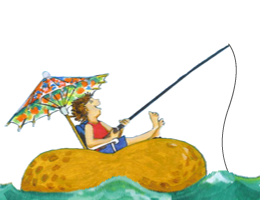
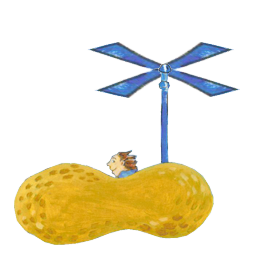
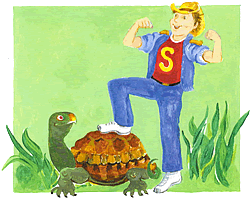 Snickerdoodle is called the “powerful pee-wee
with big ideas.” Why do you think he got that nickname?
(children’s responses?)He’s very tiny but very strong.
Super-strong, in fact. But he’s not strong because
of his muscles, like some other superheroes. He’s just
a little guy. But he’s not afraid of big tough bullies
or bad guys.
Snickerdoodle is called the “powerful pee-wee
with big ideas.” Why do you think he got that nickname?
(children’s responses?)He’s very tiny but very strong.
Super-strong, in fact. But he’s not strong because
of his muscles, like some other superheroes. He’s just
a little guy. But he’s not afraid of big tough bullies
or bad guys.
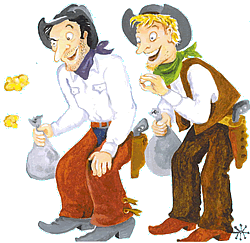 How do you think he fights the bad guys? Does he beat them
up? NO! Does he throw rocks or use a knife or a gun or a laser-beam
sword? NO! Why not?
How do you think he fights the bad guys? Does he beat them
up? NO! Does he throw rocks or use a knife or a gun or a laser-beam
sword? NO! Why not?
Because he has a better way!
Snickerdoodle is powerful because he knows how to think big and use his sense of humor and imagination to surprise his enemies—and sometimes he can turn them into friends.
So if he meets a bully, what do you think he does? (children’s responses?)
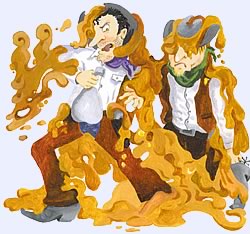 Because Snickerdoodle is so tiny, usually the
big guys don’t even see him coming. And if they do, they don’t
see how a little guy could possibly stop them from doing bad
stuff.
Because Snickerdoodle is so tiny, usually the
big guys don’t even see him coming. And if they do, they don’t
see how a little guy could possibly stop them from doing bad
stuff.
But Snickerdoodle has lots of tricks. He might tickle the bad guys so they laugh so hard they can’t do bad stuff. Or he might play a funny joke on the bad guys. Or he might just totally surprise them by being friendly (a peacemaker) until they figure out that it’s no fun to be mean.
ACTIVITIES For PreK-1 Students
- The Snickerdoodle Rap (Music /rhythm)
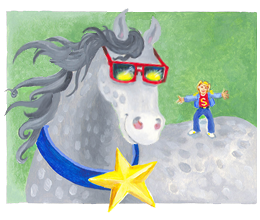 Snickerdoodle is a dude who can do it! And each one of you can be a hero, too!
Even when you are small, your big ideas and your imagination can help each
other and help the world. Think about some ways you can be a dude who can do
it like Snickerdoodle while we do this fun rap together. Hear the rap.
(If there are rhythm instruments in classroom, have children use them! Drums,
shakers, etc. Or have kids stand, do clapping, stomping, mouth sounds as rhythm
to accompany the rap. [Experiment with “Boom-chicka-boom-chicka boom boom
boom!” or another chant after main verses or refrain of the rap.] )
Snickerdoodle is a dude who can do it! And each one of you can be a hero, too!
Even when you are small, your big ideas and your imagination can help each
other and help the world. Think about some ways you can be a dude who can do
it like Snickerdoodle while we do this fun rap together. Hear the rap.
(If there are rhythm instruments in classroom, have children use them! Drums,
shakers, etc. Or have kids stand, do clapping, stomping, mouth sounds as rhythm
to accompany the rap. [Experiment with “Boom-chicka-boom-chicka boom boom
boom!” or another chant after main verses or refrain of the rap.] ) (*Optional: Teacher may follow-up the “Rap” with a free-style drawing or writing activity in which children can imagine themselves (or Snickerdoodle, or their own favorite superhero) doing a heroic deed, something funny, or something to make peace with others. Youngest children can show/tell their hero story in the class—and the teacher can post the drawings on the bulletin board, with heading, “We can think BIG! Just look what our superheroes can do!”)
-
Create Your Own Peanutmobile (preK-1, Art)
Materials Needed: pre-drawn peanut shape on butcher brown paper and cut out 2 pre-drawn round wheels to color and paste on. A steering wheel can be cut and pasted, if desired, from a sort of “T” shape, out of black or brown construction paper. Children can color and decorate the peanutmobile in their own style. (If glitter is desired, use with caution.) If they bring in photos of themselves, they can (with teacher’s help) cut it to “fit” in driver’s seat. Or a color drawing of Snickerdoodle that children make themselves or a cutout of Snickerdoodle image from website may be pasted to go in driver’s seat.
Discussion: (Option: Teacher can introduce the activity using prop of the toy doll in the peanutmobile car, and saying the “Putt-Putt-Peanut” rhyme with the very youngest children, ages 3-5)
Teacher asks: What if you had your own peanutmobile like Snickerdoodle’s. What would it look like and what could it do? Where would it go on an adventure? Would you ride in the peanut with Snickerdoodle or would you be the driver?

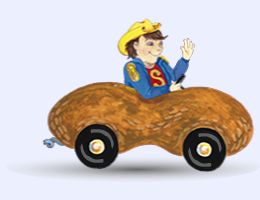

“Putt-Putt Peanut” Rhyme
© 2006 by Clare Grosgebauer
Putt-Putt Peanut
Putt-Putt Peanut!
Who’s that tiny driver
Behind the steering wheel?
Say Hi to Snickerdoodle
In his Peanutmobile!
Putt-Putt Peanut
Putt-Putt Peanut!
It goes on the road
It goes in the air
It goes in the ocean
It goes everywhere!
Putt-Putt Peanut
Putt-Putt Peanut!
What do you think?
What do you feel?
Where will you go
In the peanutmobile?
Putt-Putt Peanut
Putt-Putt Peanut!
What’s your next adventure
Just around the bend?
Riding in the peanut
With Snickerdoodle as your friend?
Putt-Putt Peanut
Putt-Putt Peanut!
With your imagination
And a spirit brave and true
You can help save the world––
Yes! Snickerdoodle and YOU!
Click here for more ART ACTIVITY Ideas!
- GAME: “On the Road to Adventure With Snickerdoodle” (K-1, Alphabet, Sequencing, Storytelling)
(For this game, teacher needs the full-color poster of Snickerdoodle, “Discover small wonders along the road less traveled.” This poster is available as a pdf for downloading/printing. Or it can be ordered as a large-size (11 x 17) glossy poster for your classroom (e-mail Clare@snickerdoodleforkids.com for more information). Teacher may use alphabet blocks or plastic letters so that each child has a letter to work with. Teacher can hand out letters or have children pick them out of a box or grab bag.)
Today we’re going to play a game of imagining adventures with Snickerdoodle. (Shows the poster—display on overhead projector or have it on easel.)
Here’s Snickerdoodle on the road to adventure. It says, Discover small wonders on the road less traveled. What do you think that means? What small wonders do you see in this picture? (bee, snail, peanut car small enough to go in Snickerdoodle’s pocket?)Let’s use our alphabet letters and imagine we’re on the trail with Snickerdoodle about to go on an adventure. We’ll each use our letter to describe something Snickerdoodle might see or something that might happen on the trail. We’ll make up a story as we go along!
Let’s start with “A.” (who has the “A”? What word that starts with an “A” would be fun to find on this trip?(For example) Let’s say, “On the road to adventure , Snickerdoodle saw a big brown fuzzy APE!”
(Teacher writes words on the easel list or blackboard, as child brings his letter and says his word, and may, if desired, draw an ape in his sketchbook or pad. Children’s drawings can be assembled later into a collage around the poster.)
Each child brings letter to teacher and stands and says, “On the road to adventure, Snickerdoodle saw (or met) an APE, and a BEAR, … and a CAT… and a DOG… and an ELEPHANT, etc… and so on.. in sequence, and each child repeating what last one said.
Teacher can help make it more of a “story” with, he turned the corner on the trail and he was in a Jungle and then he turned the corner again and was in a dry Desert, etc… and he decided to press the magic button on his peanutmobile and it became a boat /submarine/jet/ rocket/etc….and then he saw a …” And end with “ And then everyone laughed and had fun because….” (Children make up ending).
The Teacher as Storyteller for Older Children
NOTE: Lesson ideas for older children (grades 2-3-4) continue here and include more details about Snickerdoodle’s place in American folklore as a tall tale hero, inviting exploration of other tall tale heroes, discussing what makes a good tall tale story, and having students create stories about Snickerdoodle or a hero of their own.
Discussion: Today we’re going to talk about “tall tales” and how you can create one
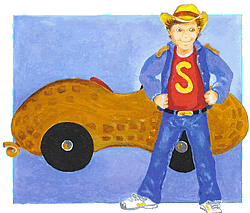 Snickerdoodle is actually a little-known tall tale hero from
American folklore, and he had lots of thrilling adventures.
What’s a tall tale?… Well, here are some examples…
Snickerdoodle is actually a little-known tall tale hero from
American folklore, and he had lots of thrilling adventures.
What’s a tall tale?… Well, here are some examples…
In World War I, airplanes were a very new invention. At night, cities had “blackouts,” which meant that all the lights of a city were turned off so that enemy airplanes flying over it couldn’t see where the city was and couldn’t bomb it. Snickerdoodle was asked by our country’s government to fly his peanut plane on a secret mission for peace to help win the War. But at night, Snickerdoodle couldn’t see the runway lights at the airport during a blackout, so he wouldn’t be able to land his plane. What did he do?
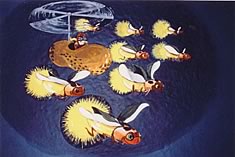 He used his imagination! He just whistled, and a whole fleet
of fireflies came to his rescue! As his escort, they blinked
their taillights on and off, shining just enough so he
could land his plane safely and deliver the Peace treaty papers!
He used his imagination! He just whistled, and a whole fleet
of fireflies came to his rescue! As his escort, they blinked
their taillights on and off, shining just enough so he
could land his plane safely and deliver the Peace treaty papers!
Another time, during World War II, Snickerdoodle was on another secret mission for our government. Like an expert Navy SEAL deep-sea diver, Snickerdoodle helped saved a submarine that had lost power and was stuck at the bottom of the ocean. Snickerdoodle called his friends, a squadron of specially trained seahorses, and together they lifted that sub to the surface again!
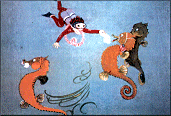 What’s a tall tale? Amazing, unbelievable, bold,
daring, optimistic, humorous adventures--“a larger-than-life” story
with a hero who thinks big!
What’s a tall tale? Amazing, unbelievable, bold,
daring, optimistic, humorous adventures--“a larger-than-life” story
with a hero who thinks big!
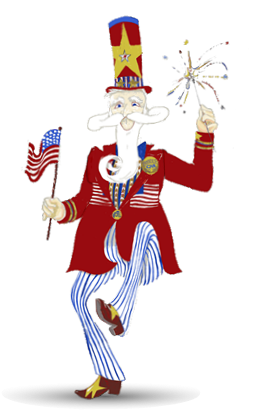 Snickerdoodle comes from a famous family from American
folklore: The Doodle Family.Have you heard of “Yankee
Doodle?” (He’s Snickerdoodle’s uncle.)
Snickerdoodle comes from a famous family from American
folklore: The Doodle Family.Have you heard of “Yankee
Doodle?” (He’s Snickerdoodle’s uncle.)
Who is Yankee Doodle? (Website searches will reveal song, origins of character, and more. Teacher might note that “Yankee Doodle” was a caricature of America made fun of by British troops during Revolutionary War, but who instead became a symbol of freedom, courage, and hope to the American colonists. Teacher can play Yankee Doodle song for kids, and different verses and versions. On the Snickerdoodle CD, there is a version of the song with new lyrics about Snickerdoodle.)
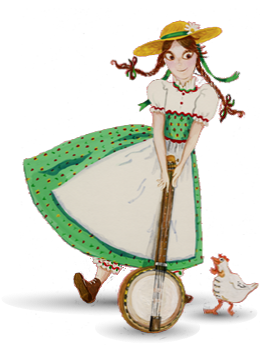 Have you heard of “Polly Wolly Doodle?” (She’s
Snickerdoodle’s cousin.) No one knows much about “her,” but
a silly song about “her” was popular in the South
after the Civil War. (Play song—again, many versions
of lyrics. New lyrics on the Snickerdoodle CD) Snickerdoodle’s
cousin Polly Wolly Doodle is a spunky country western singer who
loves to play the banjo and sing all day!
Have you heard of “Polly Wolly Doodle?” (She’s
Snickerdoodle’s cousin.) No one knows much about “her,” but
a silly song about “her” was popular in the South
after the Civil War. (Play song—again, many versions
of lyrics. New lyrics on the Snickerdoodle CD) Snickerdoodle’s
cousin Polly Wolly Doodle is a spunky country western singer who
loves to play the banjo and sing all day!
 Spitfire Jim
Spitfire Jim
 Star
Spangled Cat
Star
Spangled Cat
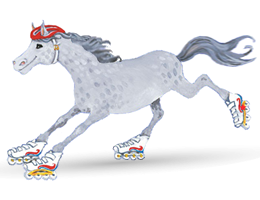 Jerry the Roller-Skating Horse
Jerry the Roller-Skating Horse In Snickerdoodle’s adventures, he sometimes got help from his family and friends—especially his animal friends. His pals include: Spitfire Jim the firehouse dog, Star-Spangled Cat, and Jerry the Roller-Skating Horse. (Teacher can print images from website or show the actual storybooks.)
(Optional: What other American folklore tall tale characters do you know? Paul Bunyan? Johnny Appleseed? Pecos Bill? Etc. Teacher may want to discuss within unit on folklore.)
(Also optional: Play the first story on the Snickerdoodle CD or from the website—the “Tall Tale About a Powerful Pee-Wee.” This is only to get students thinking more about a tall tale THEY will write about Snickerdoodle or a tall tale hero of their own imagining. Note that the story is in poetry format, but a tale need not be a poem.)
Materials Needed: Students need sketchbooks/notebooks/writing journal.
Now, it’s time to make up a story of your own—a
tall tale about Snickerdoodle, or maybe a superhero of your
own, from your imagination. Whether you draw pictures or write
words, -- whether it’s a poem, a rap, or a story, just
have fun and let your imagination fly!
Let’s review some things first about Snickerdoodle (and heroes) that you need to remember:
- Snickerdoodle (or a hero)
likes to help people.
- Snickerdoodle solves problems by using his imagination and sense
of humor. He is never mean or violent.
- Snickerdoodle ( or a hero) is humble. He doesn’t brag about himself or try to be famous.
Story Ideas: You may already have some neat ideas for your story. But in case
you don’t, here are a few tips to help get you started. You
could make up a story to answer questions like:
- Where did Snickerdoodle get his peanutmobile?
- How do you think Snickerdoodle met (other characters like
Spitfire Jim the dog, the cat, the horse?)
- What’s the funniest thing you ever saw/funniest joke Snickerdoodle could play without hurting anyone!?
(*Optional: Teacher may introduce the “unfinished” Snickerdoodle story about “Help Snickerdoodle Teach the Bullies A Lesson” and invite children to provide their own creative solutions.
Here are some ways you might begin your story…
- Once upon a time
- Long ago and far away
- Once there was
- One amazing sunshiny day
- One awful gloomy scary night
- Did you ever hear the story about
- I’ll tell you a tale
- Can you imagine
- Whoever heard of a
- What IF...?
- I wonder...
Here are some story endings you might use…
- And they lived
happily ever after.
- And that’s how Snickerdoodle (or your “hero”)
saved the day.
- And that’s why….
- Everyone cheered, and Snickerdoodle waved goodbye.
What are some settings for your story? Can you think of some interesting places Snickerdoodle (or your “hero”) might go?
- Out West
- At a rodeo
- In the jungle
- At the beach
- In the mountains
- In outer space
- At a circus
- On a treasure hunt
- Inside a magician’s hat
What about your story’s action, or plot? What is the story about? What problem does Snickerdoodle (or your “hero”) solve? How does he do it?
- Going camping
- Winning a contest
- Meeting a monster
- Racing in a peanut car (or some other vehicle)
- Riding a rollercoaster
- Rescuing a person or an animal
- Outsmarting a bully
- Building an invention to help people do….(what?)
These are just a few ideas to help you get started imagining adventures for Snickerdoodle or your own superhero. You can write or draw a story (tall tale), a poem or rap, a song, a TV script, or a cartoon. (Teacher may oversee writing/creative process over period of time, and help children make/bind their own books to share with their school library. And if students make a collaborative Snickerdoodle story (a story made up by all members of the class working together), please send it to the website at stories@snickerdoodleforkids.com to share! (See story posted by 2nd graders in Texas.)